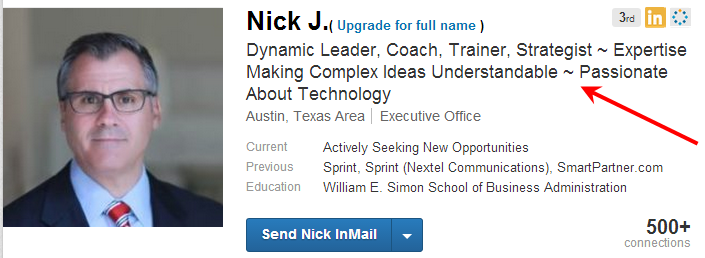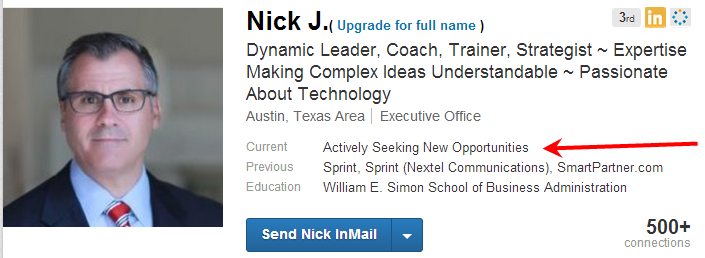This question comes up all the time when I do presentations on LinkedIn. There are a few different options, depending on the message you want to give (“I need your help…!” OR “I have expertise in this, and oh yeah, I might be open to looking at other opportunities” and everything in-between).
Recently I was talking to Nick Jenkins, a senior operations manager based out of Austin, Texas. Nick has deep experience with the telecom industry but, as we were talking, he was explaining his passion to move to a few other industries (still within technology), including mobile stuff, cloud computing, etc. Nick likes being in the leading edge tech space, which is what he navigated over the last 15 years in telecom.
As we were talking I had a thought: Your LinkedIn profile tells me you are actively looking, but nothing in your profile tells me you are not married to the telecom industry. In fact, everything there indicates you kind of want to stay there. What if you let me know you are open to non-telecom stuff?
I shared this idea with Nick and here’s what he changed to clarify his position (being available for new opportunities, and what he is open to). I think this is the best way to communicate this stuff.
First, the Professional Headline. Nick’s main message here is “I’m a professional! Here are my passions and what I bring to the table!” Instead of focusing on “I’m looking for new work,” which is NOT his brand, he focuses on what he wants you to think of when you think about him.
Next, the Current Title. He makes it very clear that he is actively looking.
Now, when I got on the phone with him, this was all that he had done. I listened to what he was looking for, and open to, and then I compared that with his profile… and therein was the problem: Without having a conversation with him to know he was looking for a career even outside of telecom (or inside of telecom, but not limited to telecom), you probably wouldn’t know that he was open to it. I suggested that he use the job experience are and tell people more about what he is looking for. His summary is the typical “here are my strengths,”… but nowhere did he say “I’m open to non-telecom opportunities.”
(Next,) So instead of leaving the job description part of “Experienced Leader and Communicator” blank, he filled it in. You can click over to his account to read it.
The takeaway for me was that I assumed, based on his profile, something that was wrong. After talking with him I understood more, and I encouraged him to share that on his Profile (to remove bad assumptions).
I challenge you to state what you do or want to do, and then read through your profile and see if they are aligned.



I don’t know, this sort of profile leaves me thinking the person doesn’t actually have any kind of specialty. I can’t even guess what area he might be interested in without scrutinizing the sections on past experience and education, so unless we’re already good friends (giving me additional info), I’m unlikely to even think about passing his name to anyone else.
I don’t disagree with you. What Nick has in the description there is just a start. I would suggest refining it so that it’s clear what he is looking for – a dream job, a dream role, what industry, example companies, why (what he could do there), etc.
It’s a lot better than when I first saw it… 🙂
You know, I don’t think it helps to say “actively seeking new opportunities.” Are recruiters searching on these terms? I doubt it. Recruiters and prospective employers care about what you can do for them, not what you’re looking for. He’s better off scrutizing groups and actively participating in new areas via comments and posts and follow-ups with people he’s interacting with on LI. Plus, the LI headline and job title fields are weighted heavily in the search results when keywords are used to find qualified candidates. The whole “passionate about” doesn’t rank in search results. My reco is to stack those fields with sharper keywords.
I used to think the same way, Maggie, and that is what I taught for a couple of years… until…
First, for someone like me (and I think him), recruiters are not a good strategy to depend on. To customize my profile to accommodate the recruiters would be a mistake.
Second, according to compete.com, the number of people visiting LI is around 40M (generously). That is what, 15% of their total member base? I know that putting and waiting is not a good strategy – you need to be more proactive.
Third, and here was my big epiphany (based on stories from others), when you let others know you are in a position of needing help, they can help you. Nick is leaving no room for his network to not know he can use their help. The rest of his profile (and changes needed in this description area) can be the keywords, but I think putting it out there that he is open and needs help is important and not a bad move.
My 2 cents 🙂